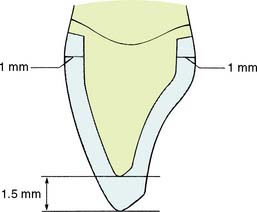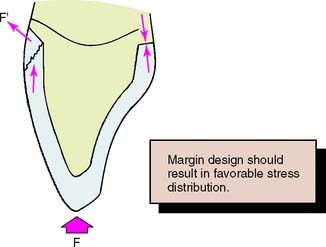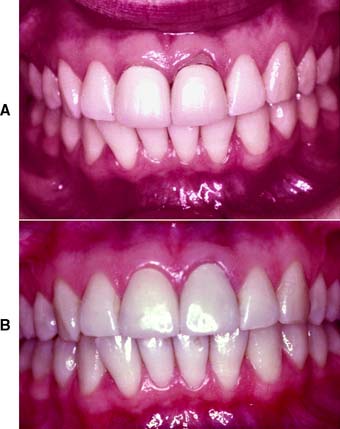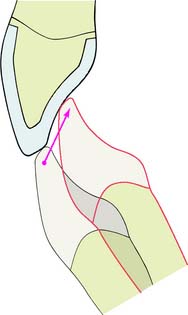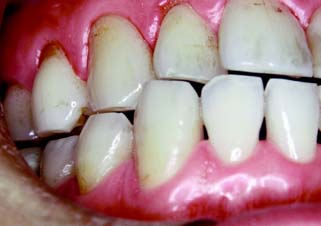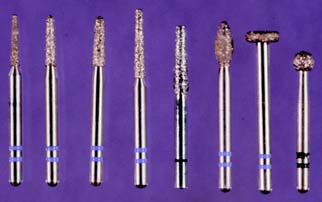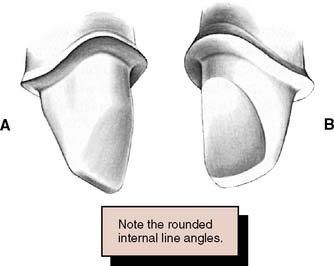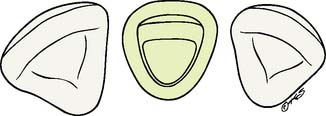11 TOOTH PREPARATION FOR ALL-CERAMIC RESTORATIONS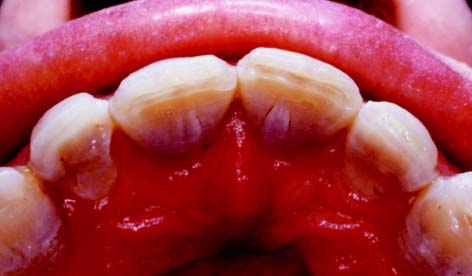
All-ceramic inlays, onlays, veneers, and crowns are some of the most esthetically pleasing prosthodontic restorations. Because there is no metal to block light transmission, they can resemble natural tooth structure better in terms of color and translucency than can any other restorative option. Their chief disadvantage is their susceptibility to fracture, although this is lessened by use of the resin-bonded technique.
Today, popular fabrication processes for the restorations include hot-pressing and slip-casting. These options are discussed in Chapter 25.
COMPLETE CERAMIC CROWNS
Complete ceramic crowns should have relatively even thickness circumferentially. For the hot-pressed ceramic crown (IPS Empress* or OPC†) (Fig. 11-1), usually about 1 to 1.5 mm is needed to create an esthetically pleasing restoration. Incisally, a greater ceramic thickness may be required.
Advantages
The advantages of a complete ceramic crown include its superior esthetics, its excellent translucency (similar to that of natural tooth structure), and its generally good tissue response. Lack of reinforcement by a metal substructure enables slightly more conservative reduction of the facial surface than is possible with the metal-ceramic crown, although the lingual surface needs additional reduction for strength. The appearance of the completed restoration can be influenced and modified by selecting different colors of luting agent. However, changing cement color under restorations that rely on an opaque core for strength, such as the slip-cast alumina core system (In-Ceram‡), is ineffective.
Disadvantages
Proper preparation design is critical to ensuring mechanical success. A 90-degree cavosurface angleis needed to prevent unfavorable distribution of stresses and to minimize the risk of fracture (Fig. 11-2). The preparation should provide support for the porcelain along its entire incisal edge, unless a ceramic system that includes a high-strength core is chosen (see Chapter 25).
All-ceramic restorations are not effective as retainers for a fixed dental prosthesis, although the strongest of the slip-cast materials (In-Ceram Zirconia§) and the higher-strength pressed systems (IPS Empress 2¶) may be suitable for anterior applications. The brittle nature of porcelain necessitates that connectors of large, cross-sectional dimension (a minimum of 4 × 4 mm is recommended) be incorporated in the fixed dental prosthesis design. This typically leads to impingement on the interdental papilla by the connector, with increased potential for periodontal failure.
Wear has been observed on the functional surfaces of natural teeth that oppose porcelain restorations. This also applies to teeth opposed by metal-ceramic restorations, especially the mandibular incisors, which can exhibit significant wear over time (see Fig. 19-1).
Indications
The complete ceramic crown is indicated in areas with a high esthetic requirement where a more conservative restoration would be inadequate (Fig. 11-3). Usually such a tooth has proximal and/or facial caries that can no longer be effectively restored with composite resin.
The tooth should be relatively intact with sufficient coronal structure to support the restoration, particularly in the incisal area, where it is important not to exceed a maximum porcelain thickness of 2 mm; otherwise, failure of the brittle material will occur.
Because of the relative weakness of the restoration, the occlusal load should be favorably distributed (Fig. 11-4). In general, this means that centric contact must be in an area where the porcelain is supported by tooth structure (e.g., in the middle third of the lingual wall).
Contraindications
The ceramic crown is contraindicated when a more conservative restoration can be used. Rarely is it recommended for molar teeth. Because of the increased occlusal load and the reduced esthetic demand, metal-ceramic restorations are the treatment of choice. If occlusal loading is unfavorable (Fig. 11-5) or if it is not possible to provide adequate support or an even shoulder width of at least1 mm circumferentially, a metal-ceramic restoration should be considered instead.
Preparation
Armamentarium
The instruments needed for preparing an all-ceramic crown (Fig. 11-6) include the following:
Step-by-step procedure
The preparation sequence for a ceramic crown (Fig. 11-7) is similar to that for a metal-ceramic crown; the principal difference is the need for a 1-mm-wide chamfer circumferentially (Fig. 11-8).
Incisal (occlusal) reduction
Facial reduction
Stay updated, free dental videos. Join our Telegram channel

VIDEdental - Online dental courses


